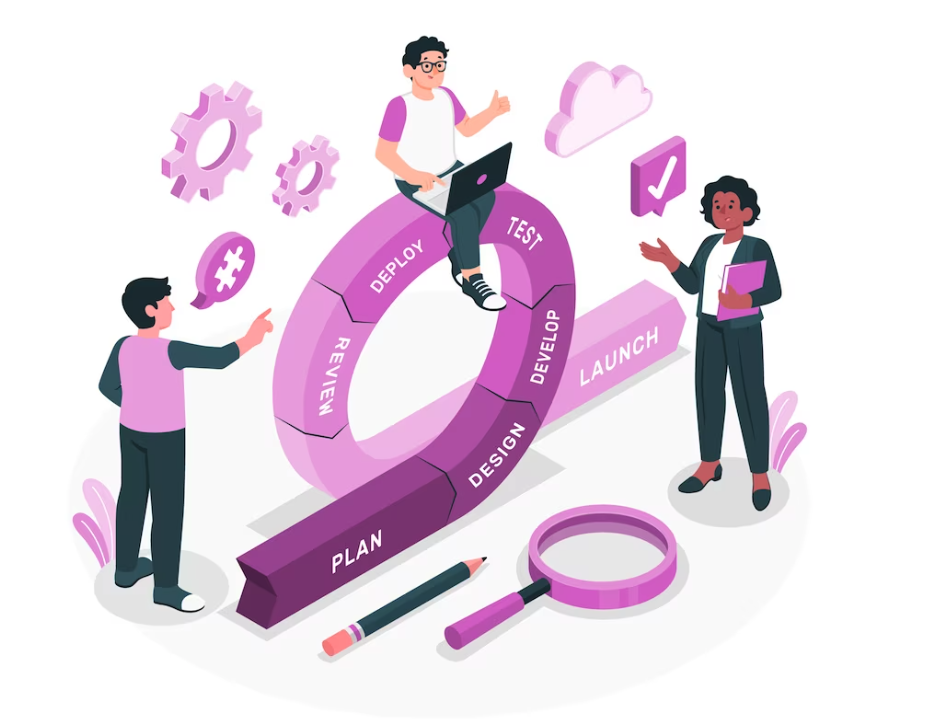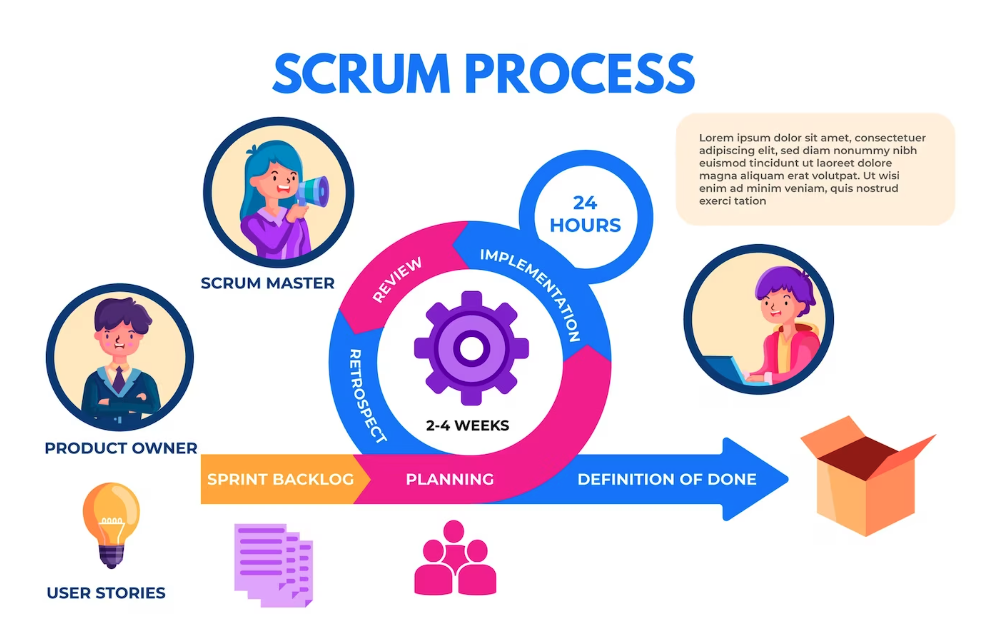Agile Methodology: Streamlining Project Management for Enhanced Efficiency
Table of Contents
Agile methodology has gained significant popularity in the field of project management due to its flexible and iterative approach. It allows teams to adapt and respond to changes effectively while delivering high-quality results within the given timeframe. In this article, we will explore the key principles, benefits, and implementation strategies of Agile methodology. Whether you’re a project manager, a team member, or someone interested in improving project outcomes, this article will provide valuable insights into harnessing the power of Agile.

1. agile methodology for software development
Agile methodology is a repetitive and incremental way to agile methodology of project management that gives importance to collaboration, flexibility, & continuous improvement. It originated in the software development industry but has since been adopted in various sectors. Unlike traditional project management methods, Agile emphasizes adaptability, customer satisfaction, and the delivery of working solutions in short iterations called sprints.
2. The Core Principles of Agile
agile methodology meaning
Agile methodology is guided by a set of core principles that shape its implementation. These principles include:
Agile methodology values customer involvement throughout the project lifecycle. It emphasizes close collaboration, feedback, and continuous communication to ensure customer satisfaction and align project outcomes with their expectations.
Agile recognizes that requirements evolve over time, and embracing change is crucial for project success. It promotes flexibility and encourages teams to adapt quickly to new information, emerging priorities, and customer feedback.
Agile methodology encourages iterative development, where projects are divided into small increments or sprints. Each sprint delivers a working product or a part of the solution, allowing for early feedback, continuous improvement, and incremental value creation.
Agile methodology promotes self-organizing teams that have the autonomy to make decisions and take ownership of their work. It fosters collaboration, trust, and shared responsibility among team members.
3. benefits
benefits of agile methodology Agile methodology offers several benefits to organizations, project managers, and team members. Some of the key advantages include:
Improved Flexibility and Adaptability
Agile allows teams to respond quickly to changes in project requirements, market conditions, and customer needs. It enables organizations to stay competitive by continuously adapting their strategies and solutions.
Enhanced Transparency and Communication
Agile fosters open communication, collaboration, and transparency among team members, stakeholders, and customers. Regular meetings, feedback loops, and visual management tools promote shared understanding and alignment.
Faster Time to Market
By breaking projects into small iterations, Agile enables faster delivery of working solutions. It allows organizations to release valuable features or products early, gaining a competitive edge and gathering feedback for future improvements.
Higher Quality Deliverables
Agile places a strong emphasis on quality throughout the project lifecycle. Continuous testing, integration, and customer involvement help identify and address issues early, resulting in higher quality deliverables.
4. Implementing Agile: Best Practices
Implementing Agile methodology requires careful planning and execution. Here are some best practices to consider:
Clearly Define Project Goals and Objectives
Before starting an Agile project, it’s essential to establish clear goals, objectives, and success criteria. This ensures that all team members are aligned and have a shared understanding of the project’s purpose.
Form Cross-Functional and Empowered Teams
Create cross-functional teams comprising individuals with diverse skills and expertise. Empower them to make decisions, take ownership, and collaborate effectively.
Break Projects into Sprints and Define User Stories
Divide projects into manageable sprints with specific goals and timeframes. Define user stories, which capture the requirements from the user’s perspective and drive the development process.
Foster Continuous Integration and Delivery
Implement tools and processes that enable continuous integration and delivery of working solutions. This ensures frequent feedback, early bug detection, and smoother releases.
Regularly Review and Adapt
Hold regular retrospectives to reflect on the team’s performance, identify areas for improvement, and implement necessary changes. Continuously refine and optimize the Agile process.
5. Agile Frameworks: Scrum, Kanban, and Lean
Agile methodology encompasses various frameworks that help teams implement its principles effectively. Three popular frameworks are Scrum, Kanban, &Lean.
Scrum
Scrum is an iterative and incremental Agile framework that enables teams to manage complex projects. It consists of predefined roles, ceremonies, and artifacts that facilitate collaboration and delivery.

H2: Kanban
Kanban is a visual management method that helps teams visualize work, limit work in progress, and improve workflow efficiency. It focuses on continuous delivery and optimizing the flow of work.
H2: Lean
Lean, derived from the Toyota Production System, emphasizes eliminating waste and maximizing customer value. It focuses on streamlining processes, reducing inefficiencies, and improving overall productivity.
6. waterfall and agile methodology
Agile methodology differs significantly from traditional project management approaches, such as the Waterfall method. While traditional methods follow a sequential and linear approach, Agile embraces flexibility, collaboration, and adaptive planning.
7. Agile Tools and Technologies agile methodology implementation
Several tools and technologies support Agile implementation and project management. These include project management software, task-tracking tools, communication platforms, and visual management boards.
8. Overcoming Challenges in Agile Adoption
Implementing Agile methodology can pose challenges, especially in organizations accustomed to traditional methods. Some common challenges include resistance to change, lack of management support, and difficulty in estimating project timelines accurately. However, proper training, effective communication, and incremental adoption strategies can help overcome these hurdles.
9. Agile Success Stories
Agile methodology has been successfully implemented by numerous organizations across various industries. Companies like Spotify, Google, and Amazon have embraced Agile to improve productivity, innovation, and customer satisfaction. Their success stories serve as inspiration for others considering Agile adoption.
10. Agile in Different Industries
Agile methodology is not limited to the software development industry. It has found applications in sectors such as marketing, manufacturing, healthcare, and education. The adaptive and collaborative nature of Agile makes it suitable for any industry that values flexibility and continuous improvement.
11. Agile Certification and Training
For professionals interested in mastering Agile methodology, various certification programs and training courses are available. These programs provide in-depth knowledge, practical skills, and industry-recognized credentials.
12. Future Trends in Agile Methodology
As organizations continue to embrace Agile, several emerging trends are shaping its future. These include scaling Agile
to enterprise-level, integrating Agile with DevOps practices, and leveraging artificial intelligence and automation in Agile project management.
13. Conclusion
Agile methodology has created a revolution in project management with its internal flexibility, collaboration with each other & customer centricity. Its repetitive & adaptive approach allows organizations to deliver high_quality solutions efficiently. By sticking to Agile principles, implementing best practices & leveraging Agile frameworks, teams can streamline their project management processes and achieve better outcomes.
14. FAQ
Q1: Is Agile methodology suitable for large-scale projects?
Yes, Agile methodology can be scaled to handle large and complex projects. Frameworks like SAFe (Scaled Agile Framework) provide guidelines for implementing Agile at an enterprise level.
Q2: Can Agile methodology be used in non-technical industries?
Absolutely! Agile methodology can be applied to any industry or domain that values flexibility, collaboration, and continuous improvement. It has been successfully implemented in marketing, healthcare, education, and more.
Q3: How does Agile methodology handle project deadlines and timelines?
Agile methodology uses fixed-duration iterations called sprints to manage project timelines. Each sprint has a specific timeframe, typically ranging from one to four weeks, and delivers a working solution or product increment.
Q4: What role does the project manager play in Agile methodology?
In Agile methodology, the project manager’s role shifts from a traditional command and control style to that of a facilitator and servant leader. They provide support, remove obstacles, and ensure the team has the necessary resources to deliver value.
Q5: What are the key challenges in Agile adoption?
Some common challenges in Agile adoption include resistance to change, cultural barriers, & the need for proper training and education. Overcoming these challenges requires a commitment to continuous improvement and a supportive organizational culture.
In conclusion, Agile methodology offers a dynamic & important approach to project management. By embracing its principles, organizations can enhance their ability to respond to change, deliver high-quality solutions, and achieve better project outcomes. Whether you’re a project manager, team member, or industry professional, understanding Agile methodology and its implementation strategies can significantly contribute to your success in the ever-evolving business landscape.
check out our other blog
GITLAB VS. GITBASH: A GREAT DESCRIPTION OF VERSION CONTROL TOOLS G0
Understanding Initial Public Offerings (IPOs): A Comprehensive and amazing Guide.0

